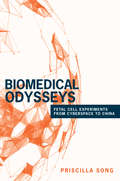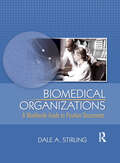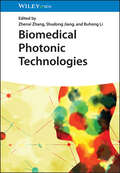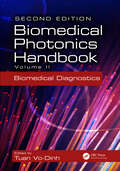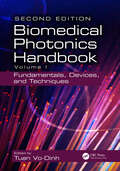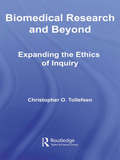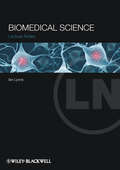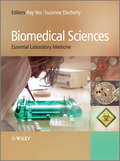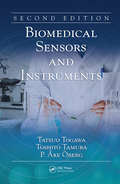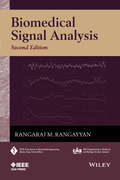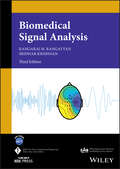- Table View
- List View
Biomedical Odysseys: Fetal Cell Experiments from Cyberspace to China
by Priscilla SongThousands of people from more than eighty countries have traveled to China since 2001 to undergo fetal cell transplantation. Galvanized by the potential of stem and fetal cells to regenerate damaged neurons and restore lost bodily functions, people grappling with paralysis and neurodegenerative disorders have ignored the warnings of doctors and scientists back home in order to stake their futures on a Chinese experiment. Biomedical Odysseys looks at why and how these individuals have entrusted their lives to Chinese neurosurgeons operating on the forefront of experimental medicine, in a world where technologies and risks move faster than laws can keep pace. Priscilla Song shows how cutting-edge medicine is not just about the latest advances in biomedical science but also encompasses transformations in online patient activism, surgical intervention, and borderline experiments in health care bureaucracy.Bringing together a decade of ethnographic research in hospital wards, laboratories, and online patient discussion forums, Song opens up important theoretical and methodological horizons in the anthropology of science, technology, and medicine. She illuminates how poignant journeys in search of fetal cell cures become tangled in complex webs of digital mediation, the entrepreneurial logics of postsocialist medicine, and fraught debates about the ethics of clinical experimentation.Using innovative methods to track the border-crossing quests of Chinese clinicians and their patients from around the world, Biomedical Odysseys is the first book to map the transnational life of fetal cell therapies.
Biomedical Optical Imaging Technologies: Design and Applications (Biological and Medical Physics, Biomedical Engineering)
by Rongguang LiangThis book provides an introduction to design of biomedical optical imaging technologies and their applications. The main topics include: fluorescence imaging, confocal imaging, micro-endoscope, polarization imaging, hyperspectral imaging, OCT imaging, multimodal imaging and spectroscopic systems. Each chapter is written by the world leaders of the respective fields, and will cover: principles and limitations of optical imaging technology,system design and practical implementation for one or two specific applications, including design guidelines, system configuration, optical design, component requirements and selection, system optimization and design examples,recent advances and applications in biomedical researches and clinical imaging. This book serves as a reference for students and researchers in optics and biomedical engineering.
Biomedical Optical Sensors: Differentiators for Winning Technologies (Biological and Medical Physics, Biomedical Engineering)
by Richard De La Rue Hans Peter Herzig Martina GerkenThis book provides wide-ranging coverage of current developments in biomedical sensing based on photonic techniques. Biomedical sensing is a dynamic topic that promises to deliver much in the future evolution of medical diagnostics, delivering advanced tools for fundamental research in biology at the micrometre and nanometre scales. The book explores a variety of alternative physical and biological methodologies that have become available for application, such as plasmonic sensors and photonic crystal biosensors. At the same time, it addresses issues that potentially limit the capability of biomedical optical sensing techniques, while reviewing the state-of-the-art in biomedical optical sensing for the future work that will lead to near-universal applications of such techniques. Edited and written by leading experts in this domain, this book is ideal as a comprehensive manual for researchers and graduate students.
Biomedical Optics in Otorhinolaryngology: Head and Neck Surgery
by Brian J.-F. Wong Justus IlgnerBiomedical Optics in Otorhinolaryngology: Head and Neck Surgery gives an overview of current technology in biomedical optics relevant to the field of Otorhinolaryngology and head and neck surgery. It provides a comprehensive source of knowledge for researchers and active clinicians seeking information on the principles and practical use of novel diagnostic and therapeutic technology. While most books focus exclusively on laser surgery, which has been largely unchanged for the past 15 years, optical diagnostics and head and neck PDT (photodynamic therapy) are usually entirely overlooked. This book contains a basic introduction into the physics of light and its propagation, lasers and low-coherent light sources, and photon-tissue interaction in relation to therapeutic and diagnostic use. The principles of various imaging techniques are also discussed ( i. e. optical coherence tomography in its variations), as well as the principles and practice of lasers for surgical use on the therapeutic side.
Biomedical Organizations: A Worldwide Guide to Position Documents
by Dale StirlingDetermine what organizations have issued position statements on a specific subject!A position document establishes the view of an organization based on its knowledge on the subject at that specific time. Biomedical Organizations: A Worldwide Guide to Position Documents puts the results of a survey of hundreds of global medical organizations and their position statements at your fingertips. This comprehensive reference not only analyzes and discusses the history and characteristics of the creation and development of the organizational position statement, but also lists medical organizations and their Web site addresses, and presents an alphabetical index of their position statements. Indexed according to subject as well as by organization, this one-of-a-kind source allows readers to determine what organizations have issued position documents on a specific subject such as alcoholism or HIV, as well as providing an appendix listing biomedical organizations without position documents. Over several years the author compiled this extensive index, which is designed to help physicians, fellows, residents, interns, medical students, and paramedical personnel to drastically cut their research time. Information can be found with ease quickly, as the index lists organizations by country, medical practice areas, and the core areas of interest of each organization. Ideally suited as a hands-on reference text in clinics, hospitals, and medical libraries, this reference cuts through the overwhelming mountain of information to give medical professionals exactly the information they are searching for while providing a historical account of position documents, their growth, their continued use, and their efficacy. Biomedical Organizations: A Worldwide Guide to Position Documents reveals the organizations with position statements on a wide variety of subjects, such as: abortion AIDS cancer diabetes homosexuality immunization long-term care mental retardation midwives malpractice nutrition ozone the Persian Gulf war pharmaceuticals pollution radon tissue transplants violence and hundreds of others!Biomedical Organizations: A Worldwide Guide to Position Documents is a timesaving reference helpful to medical professionals, students, educators, and professional medical organizations.
Biomedical Perspectives of Herbal Honey
by Rajesh Kumar Suresh Kumar Shamsher S KanwarThis book overviews honey and herbs that profoundly affect human metabolism when mixed in a balanced ratio. It covers various aspects of honey added to herbs and provides collective information and practical approaches regarding herbal honey and its applications as functional food and medicine. Honey has miraculous properties like anti-bacterial, anti-fungal, free radical scavenging, and anti-carcinogenic, so honey has tremendous therapeutic importance. Infusion of extract from various medicinal herbs in honey further modulates its therapeutic potential. This book provides all the information about the essentials of herbs-infused honey and its efficiency in fighting against pathogenic bacteria. It presents the significance and benefits of honey infused with herbs that may promote/boost immunity to fight contagious or non-contagious diseases. Not only does this book explain the comprehensive knowledge of herbal honey and its medicinal properties based on current researched evidence, but it also explores the contribution of herbal honey in the food science and medicine industry as a significant part of nutraceuticals and functional food research. By providing knowledge about the formulation of traditionally used herbs in combination with honey, scientific knowledge can be supplied and made available to the common public which shall probably be a real contribution to society.
Biomedical Photoacoustics: Technology and Applications
by Wenfeng XiaPhotoacoustic imaging (also called optoacoustic imaging) is a hybrid modality based on the generation and detection of ultrasound in response to optical absorption of tissue. It combines advantages from both optical and ultrasound imaging, providing functional, molecular and microstructural information of tissue at scalable spatial resolution and depth. This technology has undergone exponential growth over the last two decades, and it is now widely viewed as one of the most exciting biomedical imaging modalities. This book introduces the technology and applications with chapters written by leading international research groups. It will be of interest to a wide range of audiences, including postgraduate students and researchers in physics and engineering as well as biomedical and clinical sciences. Chapters 8, 16, 17 and 21 are available open access under a Creative Commons Attribution 4.0 International License via link.springer.com.
Biomedical Photonic Technologies
by Shudong Jiang Zhenxi Zhang Buhong LiBiomedical Photonic Technologies A state-of-the-art examination of biomedical photonic research, technologies, and applications In Biomedical Photonic Technologies, a team of distinguished researchers delivers a methodical inquiry and evaluation of the latest developments in the field of biomedical photonics, with a focus on novel technologies, including optical microscopy, optical coherence tomography, fluorescence imaging-guided surgery, photodynamic therapy dosimetry, and optical theranostic technologies. Each discussion of individual technologies includes examples of their contemporary application in areas like cancer therapy and drug delivery. Readers will discover the major research advancements in biomedical photonics from the last 20 years, ascertaining the basic principles of formation, development, and derivation of biomedical photonics phenomena at a variety of scales. Readers will also find: A thorough introduction to advanced wide-field fluorescent microscopy for biomedicine Comprehensive explorations of fluorescence resonance energy transfer and optical coherence tomography for structural and functional imaging Practical exploration of coherent Raman scattering microscopy and biomedical applications, as well as fluorescence image-guided surgery Complete analyses of enhanced photodynamic therapy, optogenetics, and optical theranostics employing gold nanoparticles Perfect for biophysicists and applied physicists, Biomedical Photonic Technologies will also benefit bioengineers and biotechnologists in academia and in industry.
Biomedical Photonics Handbook: Biomedical Diagnostics
by Tuan Vo-DinhShaped by Quantum Theory, Technology, and the Genomics RevolutionThe integration of photonics, electronics, biomaterials, and nanotechnology holds great promise for the future of medicine. This topic has recently experienced an explosive growth due to the noninvasive or minimally invasive nature and the cost-effectiveness of photonic modalities in
Biomedical Photonics Handbook: Fundamentals, Devices, and Techniques
by Tuan Vo-DinhShaped by Quantum Theory, Technology, and the Genomics RevolutionThe integration of photonics, electronics, biomaterials, and nanotechnology holds great promise for the future of medicine. This topic has recently experienced an explosive growth due to the noninvasive or minimally invasive nature and the cost-effectiveness of photonic modalities in
Biomedical Photonics Handbook: Therapeutics and Advanced Biophotonics
by Tuan Vo-DinhShaped by Quantum Theory, Technology, and the Genomics RevolutionThe integration of photonics, electronics, biomaterials, and nanotechnology holds great promise for the future of medicine. This topic has recently experienced an explosive growth due to the noninvasive or minimally invasive nature and the cost-effectiveness of photonic modalities in
Biomedical Photonics for Diabetes Research (Series in Medical Physics and Biomedical Engineering)
by Valery Tuchin Andrey V. DunaevIn 2021, over 537 million people worldwide were diagnosed with diabetes, according to the International Diabetes Federation and so the diagnosis, care and treatment of patients with diabetes mellitus have become one of the highest healthcare priorities. Biomedical photonics methods have been found to significantly improve and assist in the diagnosis of various disorders and complications arising from diabetes. These methods have also been widely used in various studies in the field of diabetes, including in the assessment of biochemical characteristics, metabolic processes, and microcirculation that are impaired in this disease. This book provides an introduction to methods of biomedical photonics. The chapters, written by world-leading experts, cover a wide range of issues, including the theoretical basis of different biophotonics methods and practical issues concerning the conduction of experimental studies to diagnose disorders associated with diabetes. It provides a comprehensive summary of the recent advances in biomedical optics and photonics in the study of diabetes and related complications. This book will be of interest to biomedical physicists and researchers, in addition to practicing doctors and endocrinologists looking to explore new instrumental methods for monitoring the effectiveness of patient treatment. Features • The first collective book combining accumulated knowledge and experience in the field of diabetes research using biophotonics. • Contributions from leading experts in the field. • Combines the theoretical base of the described methods and approaches, as well as providing valuable practical guidance and the latest research from experimental studies.
Biomedical Polymers: Synthesis and Processing (SpringerBriefs in Applied Sciences and Technology)
by Vinod B. Damodaran Divya Bhatnagar N. Sanjeeva MurthyThis book presents a comprehensive review on the various processing and post-processing methodologies for biodegradable polymers. Written by professionals with hands-on experience on polymer processing, this book provides first-hand knowledge of all contemporary processing techniques. The current status and future challenges in the field are described, as well as a framework for designing novel devices for desired applications.
Biomedical Product Development: Bench to Bedside (Learning Materials in Biosciences)
by Babak Arjmand Moloud Payab Parisa GoodarziThis textbook covers all the steps in manufacturing a biomedical product from bench to bedside. It specifically focuses on quality assurance and management and explains the different good practice principles in the various phases of product development as well as how to fulfill them: Good laboratory practice, good manufacturing practice and good clinical practice. It provides readers with the know-how to design biomedical experiments to ensure quality and integrity, to plan and conduct standard preclinical studies and to assure the quality of the final manufactured biomedical products. Importantly, it also addresses ethical concerns and considerations.The book discusses the guidelines and ethical considerations for preclinical and clinical studies, to allow readers to identify safety concerns regarding biomedical products and to improve pre-clinical studies for the development of better products.This textbook is a valuable guide for biomedical students (B.Sc., M.S., and Ph.D. students) in the field of molecular medicine, medical biotechnology, stem cell research and related areas, as well as for professionals such as quality control staff, tissue bankers, policy-makers and health professionals.
Biomedical Research and Beyond: Expanding the Ethics of Inquiry (Routledge Annals of Bioethics #Vol. 5)
by Christopher O. TollefsenWhat is the relationship between scientific research and ethics? Some think that science should be free from ethical and political considerations. Biomedical Research and Beyond argues that ethical guidance is essential for all forms of inquiry, including biomedical and scientific research. By addressing some of the most controversial questions of biomedical research, such as embryonic research, animal research, and genetic enhancement research, the author argues for a rich moral framework for the ethics of inquiry, based on the ideal of human flourishing. He then looks at other areas of inquiry, such as journalistic ethics, and military investigation, to see how similar they are to the ethics of scientific research. Finally, he looks at the virtues that must play a role in any life that is devoted to research and inquiry as a vocational commitment.
Biomedical Research and Integrated Biobanking: An Innovative Paradigm For Heterogeneous Data Management (Springer Theses)
by Massimiliano IzzoThis doctoral thesisreports on an innovative data repository offering adaptive metadata managementto maximise information sharing and comprehension in multidisciplinary andgeographically distributed collaborations. It approaches metadata as a fluid,loosely structured and dynamical process rather than a fixed product, anddescribes the development of a novel data management platform based on aschemaless JSON data model, which represents the first fully JSON-basedmetadata repository designed for the biomedical sciences. Results obtainedin various application scenarios (e. g. integrated biobanking, functionalgenomics and computational neuroscience) and corresponding performance testsare reported on in detail. Last but not least, the book offers a systematicoverview of data platforms commonly used in the biomedical sciences, togetherwith a fresh perspective on the role of and tools for data sharing andheterogeneous data integration in contemporary biomedical research.
Biomedical Research, Medicine, and Disease (Translating Animal Science Research)
by R. C. Sobti Aastha SobtiBiomedical research is the first step towards the creation of new medications and treatments that help to manage different types of health conditions and diseases. The prevention and cure of diseases would be practically impossible without such type of research. Although the drug discovery and development processes are far too costly, time-consuming, prone to failure, and have low success rate, today the term "translational research or medicine" seems to have become trendy, yet it is insufficient. The present book is a sincere attempt by dedicated researchers to convey the importance of translational biomedical research, medicine, and disease, primarily, basic and clinical difficulties in the translation of diagnostic measures, pharmaceutical advances, biomarkers, diagnostics, and therapeutics. This book is meant for researchers, scientists, healthcare professionals, industry, innovators, and students of biomedical sciences, as well as for those involved in the basic sciences, biochemistry, biotechnology, biophysics, and life sciences in general. The volume comprehensively covers i. Emerging technologies for health care, ii. Various aspects of biomedical research toward understanding of pathophysiology of the diseases, iii. Advances in improvement in diagnostic procedures and therapeutic tools, iv. The fundamental role of biomedical research in the development of new medicinal products.
Biomedical Research: An Insider's Guide
by Seward B. RutkoveThis comprehensive yet concise title is a guide to introducing people at all levels of training--undergraduate students, graduate students, medical students, residents, fellows and junior faculty--to the basic joys and pains of research. In doing so, this fun and easy-to-read guide offers thorough information to allow people to determine for themselves whether research is really for them. By outlining all of the key issues in a biomedical research career, would-be and early-stage researchers will not only be better informed about the world of biomedical research, but will learn a basic set of instructions to help initiate their careers. Biomedical Research: An Insider's Guide is divided into several sections. The first focuses on decision points regarding whether one wants to enter into research and which type for which type of person--basic, clinical, or translational. The second section focuses on some basic practicalities of pursuing medical research, including institutional review boards and animal care committees as well general suggestions regarding idea generation and collaboration. The third section covers a core aspect of research: writing--detailing the writing of both grants and papers. The fourth section addresses a range of issues, including conferencing to patents to industry to philanthropy. The final section deals with the all-important broader life issues from job choices to thoughts on trying to keep the big picture front and center as one moves through a research-infused career. An invaluable resource that offers insightful, practical advice, Biomedical Research: An Insider's Guide is the go-to guide that shows how biomedical research is not only filled with multiple challenges, but is also truly and inexplicably enjoyable.
Biomedical Science (Lecture Notes #42)
by Ian LyonsThis brand new Lecture Notes title provides the core biomedical science study and revision material that medical students need to know. Matching the common systems-based approach taken by the majority of medical schools, it provides concise, student-led content that is rooted in clinical relevance. The book is filled with learning features such as key definitions and key conditions, and is cross-referenced to develop interdisciplinary awareness. Although designed predominantly for medical students, this new Lecture Notes book is also useful for students of dentistry, pharmacology and nursing. Biomedical Science Lecture Notes provides: A brand new title in the award-winning Lecture Notes series A concise, full colour study and revision guide A 'one-stop-shop' for the biomedical sciences Clinical relevance and cross referencing to develop interdisciplinary skills Learning features such as key definitions to aid understanding
Biomedical Sciences
by Suzanne Docherty Raymond IlesBiomedical Sciences is an indispensable, all encompassing core textbook for first/ second year biomedical science students that will support them throughout their undergraduate career. The book includes the key components of the IBMS accredited degree programmes, plus sections on actual practice in UK hospital laboratories (including the compilation of a reflective portfolio).The book is visually exciting, and written in an interesting and accessible manner while maintaining scientific rigour. Highlighted boxes within the text link the theory to actual clinical laboratory practice for example, the histopathology chapter includes a photographically illustrated flow chart of the progress of a specimen through the histopathology lab, so that students can actually see how the specimen reception/inking/cut-up/cassette/block/section/stain system works, with an emphasis on the safety procedures that ensure specimens are not confused).
Biomedical Sensing and Analysis: Signal Processing in Medicine and Biology
by Iyad Obeid Ivan Selesnick Joseph PiconeThis book provides an interdisciplinary look at emerging trends in signal processing and biomedicine found at the intersection of healthcare, engineering, and computer science. Bringing together expanded versions of selected papers presented at the 2020 IEEE Signal Processing in Medicine and Biology Symposium (IEEE SPMB), it examines the vital role signal processing plays in enabling a new generation of technology based on big data and looks at applications ranging from medical electronics to data mining of electronic medical records. Topics covered include analysis of medical images, machine learning, biomedical nanosensors, wireless technologies, and instrumentation and electrical stimulation. Biomedical Sensing and Analysis: Signal Processing in Medicine and Biology presents tutorials and examples of successful applications, and will appeal to a wide range of professionals, researchers, and students interested in applications of signal processing, medicine, and biology.Presents an interdisciplinary look at research trends in signal processing and biomedicine;Promotes collaboration between healthcare practitioners and signal processing researchers;Includes tutorials and examples of successful applications.
Biomedical Sensors and Instruments
by Tatsuo Tagawa Toshiyo Tamura P. Ake ObergThe living body is a difficult object to measure: accurate measurements of physiological signals require sensors and instruments capable of high specificity and selectivity that do not interfere with the systems under study. As a result, detailed knowledge of sensor and instrument properties is required to be able to select the "best" sensor from o
Biomedical Signal Analysis
by Rangaraj M. RangayyanThe book will help assist a reader in the development of techniques for analysis of biomedical signals and computer aided diagnoses with a pedagogical examination of basic and advanced topics accompanied by over 350 figures and illustrations. Wide range of filtering techniques presented to address various applications 800 mathematical expressions and equations Practical questions, problems and laboratory exercises Includes fractals and chaos theory with biomedical applications
Biomedical Signal Analysis (IEEE Press Series on Biomedical Engineering)
by Rangaraj M. Rangayyan Sridhar KrishnanBiomedical Signal Analysis Comprehensive resource covering recent developments, applications of current interest, and advanced techniques for biomedical signal analysis Biomedical Signal Analysis provides extensive insight into digital signal processing techniques for filtering, identification, characterization, classification, and analysis of biomedical signals with the aim of computer-aided diagnosis, taking a unique approach by presenting case studies encountered in the authors’ research work. Each chapter begins with the statement of a biomedical signal problem, followed by a selection of real-life case studies and illustrations with the associated signals. Signal processing, modeling, or analysis techniques are then presented, starting with relatively simple “textbook” methods, followed by more sophisticated research-informed approaches. Each chapter concludes with solutions to practical applications. Illustrations of real-life biomedical signals and their derivatives are included throughout. The third edition expands on essential background material and advanced topics without altering the underlying pedagogical approach and philosophy of the successful first and second editions. The book is enhanced by a large number of study questions and laboratory exercises as well as an online repository with solutions to problems and data files for laboratory work and projects. Biomedical Signal Analysis provides theoretical and practical information on: The origin and characteristics of several biomedical signals Analysis of concurrent, coupled, and correlated processes, with applications in monitoring of sleep apnea Filtering for removal of artifacts, random noise, structured noise, and physiological interference in signals generated by stationary, nonstationary, and cyclostationary processes Detection and characterization of events, covering methods for QRS detection, identification of heart sounds, and detection of the dicrotic notch Analysis of waveshape and waveform complexity Interpretation and analysis of biomedical signals in the frequency domain Mathematical, electrical, mechanical, and physiological modeling of biomedical signals and systems Sophisticated analysis of nonstationary, multicomponent, and multisource signals using wavelets, time-frequency representations, signal decomposition, and dictionary-learning methods Pattern classification and computer-aided diagnosis Biomedical Signal Analysis is an ideal learning resource for senior undergraduate and graduate engineering students. Introductory sections on signals, systems, and transforms make this book accessible to students in disciplines other than electrical engineering.
Biomedical Signal Processing for Healthcare Applications (Emerging Trends in Biomedical Technologies and Health informatics)
by G. R. Sinha Chinmay Chakraborty Varun BajajThis book examines the use of biomedical signal processing—EEG, EMG, and ECG—in analyzing and diagnosing various medical conditions, particularly diseases related to the heart and brain. In combination with machine learning tools and other optimization methods, the analysis of biomedical signals greatly benefits the healthcare sector by improving patient outcomes through early, reliable detection. The discussion of these modalities promotes better understanding, analysis, and application of biomedical signal processing for specific diseases. The major highlights of Biomedical Signal Processing for Healthcare Applications include biomedical signals, acquisition of signals, pre-processing and analysis, post-processing and classification of the signals, and application of analysis and classification for the diagnosis of brain- and heart-related diseases. Emphasis is given to brain and heart signals because incomplete interpretations are made by physicians of these aspects in several situations, and these partial interpretations lead to major complications. FEATURES Examines modeling and acquisition of biomedical signals of different disorders Discusses CAD-based analysis of diagnosis useful for healthcare Includes all important modalities of biomedical signals, such as EEG, EMG, MEG, ECG, and PCG Includes case studies and research directions, including novel approaches used in advanced healthcare systems This book can be used by a wide range of users, including students, research scholars, faculty, and practitioners in the field of biomedical engineering and medical image analysis and diagnosis.
